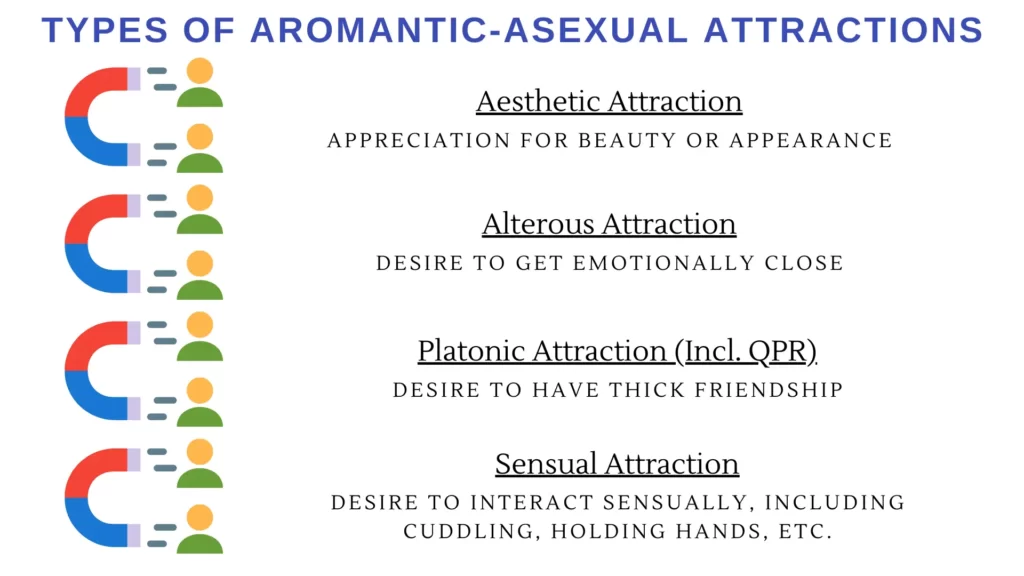
The oriented aroace label is one of the more recent additions to the sexuality / asexuality / aromantic spectrum and arguably one of the most complex ones to fathom. Let us understand the terminology involved before we develop the questions further and discuss the answers in detail.
What is Aroace | Aroace Meaning
AroAce is a portmanteau of two words – Aromantic and Asexual (ace) – taking ‘aro’ from the former and the contraction of asexual, i.e. ‘ace‘ from the latter. AroAce is an individual who relates with two distinct identities, namely, aromantic – which refers to the absence of romantic attraction in the individual towards another person, and asexual (ace) – which refers to the inability of the individual to experience sexual attraction toward another person.
What does “Oriented” mean?
The literal meaning of the word oriented is – to be positioned relatively toward or away from something or to be interested in something. Going by a combination of both the meanings, to be ‘oriented’ would mean ‘aligned’ toward somebody, so to speak.
Now let us combine the two terms – oriented and aroace – and read it together. You will realize that the qualifying word here is ‘oriented’. In other words, the word ‘oriented’ qualifies the meaning of the term Aroace to mean a subset of aroace exclusive in itself.
Therefore, we get to know that we are talking about an aromantic-asexual person who feels drawn or attracted toward other persons, and, in that manner, is distinct from the other aroaces. This other person can be of any gender identity and sexual orientation.
Tertiary Attractions
People in the aromantic and asexual communities have been attempting to classify the different kinds of attractions that they experience. The focus, so far, outside these communities was on romantic and sexual attraction. Therefore, it was felt that a third kind of attraction had to exist to explain the kind of affinity experienced by the aromantic and asexual people. This third kind of attraction came to be known as tertiary attraction.

Aesthetic attraction refers to the appreciation for the appearance or beauty of a person.
Alterous attraction is the middle path between platonic and romantic and refers to a person’s feeling to get emotionally close to another person.
Platonic attraction is the keenness to have friendship with another person. You may also count queerplatonic in this which is actually a platonic attraction with an element of queerness, which means that the rules will be written by the person feeling the attraction.
Sensual attraction is the interaction that happens in a non-sexual way, which may include hugging or cuddling.
The concept of tertiary attraction is seminal to the development of the idea of oriented aroace. We are now in a position to attempt to define the term.
What is Oriented Aroace ? A definition.
An oriented aroace is an aromantic and asexual individual who experiences tertiary attraction, such as aesthetic or alterous or platonic (or queerplatonic) or sensual attraction, to an extent that positioning this non-sexual and aromantic attraction alongside their aroace identity becomes necessary to correctly express themselves.

For instance, if a cis-gender woman identifies as an oriented aroace, this person may feel drawn toward, say, a cis-gender male or a cis-gender woman or both. One can draw up several such permutations and therefore, may identify as aroace lesbian or bi-oriented aroace or gay aroace and so on.
As a corollary, it can be said that this orientation can be felt toward persons of more than one gender identity and sexual orientation.
Is this classification of Oriented Aroace really necessary?
We are talking about one’s placement along the sexuality (or asexuality) spectrum. Confusion is common, especially in the youth, as to their exact positioning which is quite natural. It is compounded by society and the establishment forcing people to select one of the two or three broad categories of gender identities and sexual orientations prescribed by them.
Over the course of the past few decades, people have been able to overcome this coercion and set out on a journey to discover their true gender identities and sexual (or asexual) orientations. As a result, experts felt the need to expand the spectrum of gender identity and sexual orientation to accommodate people who could not identify with the available ones defined on the spectrum.
One such point along the spectrum is Oriented Aroace which is a much debated expression used by some people. The debate is around whether there exists such a form of sexuality (or asexuality). (We will deal with this in the next section of this article.)
The classification is important and necessary for people to be able to describe themselves and share how they feel. It gives them the descriptive vocabulary to express themselves precisely in order to be understood without any room for ambiguity and for the people in general to be able to comprehend exactly the feelings that are being expressed.
Therefore, the importance of having such complex terms lies in the fact that it aids in better communication.
Read also: Sapphic Flag
Why is Oriented Aroace a difficult label to understand?
The contradiction in the term ‘oriented aroace’ emerges because, on the one hand it is being said that an aroace person does not feel romantic or sexual attraction, and on the other this person talks of being attracted toward another person.
Whether such a thing exists is a frequently asked question on social media forums, such as Reddit and Quora, the responses to which are typically brief, and one is left wanting a detailed authoritative explanation. With this article, genderisothing.com wishes to delve deeper and clear the clouds of confusion.
How can I be an aroace (aromantic and asexual) and still be oriented?
The first thing to understand is that orientation is neither a strictly romantic nor a strictly sexual construct. In the simple terms that we defined ‘oriented’ above, it means alignment of an individual toward somebody who may be of a certain gender identity and sexual orientation.
This alignment or preference of the aroace individual for the company of another person for reasons entirely of non-romantic and asexual nature is actually what makes the aroace individual identify as an oriented aroace.
An aroace individual may observe a pattern of inclination toward another person that is purely aesthetic or sensual or alterous or platonic in character and over a period of time, be sure that it is distinct and devoid of romantic or sexual attraction. In such a scenario, this aroace individual can quite certainly identify as an oriented aroace.
The aroaces who have identified as oriented then have to get on to the next obvious question of the right orientation label that aptly describes them. They may identify as an aroace lesbian or a bi-oriented aroace or a gay-oriented aroace or pan-oriented aroace and so on.
Split Attraction Model (SAM) for explaining Oriented Aroace
People from within the asexual community have used the Split Attraction Model (SAM) to explain how being oriented aroace is possible. The Split Attraction Model is a conceptual model which postulates that romantic and sexual attractions experienced by an individual can be distinct from each other. The model allows for a person to feel romantically inclined to one person while feeling no sexual attraction for that person and vice-versa.
The Split Attraction Model (SAM) was originally conceptualized in 1879 and was adopted by the aromantic and asexual communities around 2015 to fill the gaps in vocabulary and understanding of their identities. However, the Split Attraction Model in its original form fails to explain the existence of oriented aroace as an identity.
A related research study published in the year 2022 gives copious insights into the associations formed by asexuals which can be extrapolated to understand relationships formed by aromantics and aroaces.
You can think of the feeling of being ‘oriented’ experienced by aroaces as a preoccupation with an available other person. It can also be understood as a reassurance-seeking behavior that the aroace individual exhibits which is an underlying cause of the feeling of being oriented toward the person from whom the reassurance is expected.
Needless to say, the aroace individuals who form connections explained under the split attraction model are more akin to deep friendships, platonic and queerplatonic relationships (QPRs), etc.
Explanation in simple terms about Oriented Aroace
Human beings are gregarious and feel the need for companionship. They feel more comfortable when this companion is a relatively more constant one. Does that sound like a romantic or sexual relationship? It does not.
It is not unusual for people to desire a relationship just to be able to navigate life in a more interesting manner. This relationship can be about doing things together, sharing thoughts and experiences, to have somebody to fall back on when in doubt or in a crisis, to seek advice and above all, it is about being valued and cared for.
You may also think of it in terms of the degree of comfort that an aroace individual would feel when in the presence of persons of different gender identities and orientations. Given such alternatives, the aroace person may be relatively more satisfied in their interaction with persons of a particular gender identity. This feeling may motivate the aroace individual to invest more in this category of persons without ever having any romantic or sexual feelings for them. Such overtures would qualify for the aroace to identify as being oriented.
All along this discussion, I get reminded of the example of two roommates living and experiencing life together. There isn’t even a smattering of romance or sex in that and yet their relationship and bonding can be very special and fulfilling.
Oriented Aroace Vs Angled Aroace
Angled aroace refers to an individual who identifies as both aroace and asexual, however experiences some form of sexual or romantic or tertiary attraction leading to the qualification of the aroace individual as “angled”. The key thing to note about an angled aroace is that such an individual is not strictly aromantic asexual. It is understood that the term was coined by a Tumblr user in the year 2019.
Two key differences between Oriented Aroace and Angled Aaroace
- Oriented aroaces are strictly aromantic and asexual, whereas angled aroaces are not strictly aroace.
- Oriented aroaces feel only tertiary attractions towards others, however, angled aroaces feel some kind of sexual, romantic or tertiary attraction.
Oriented Aroace Test (Self-Administered)
A simple four-step, self-administered test can help you determine whether you can identify as an oriented aroace.
- Are you an aroace, i.e. an aromantic and asexual person? (Please refer to the definition of Aroace in section 3 of this article to answer this question.)
- If the answer to the first question is in the affirmative, do you ever feel “attracted” to another person?
- If you do, is this attraction strong enough to probe the “nature” of this attraction?
- Does the attraction felt by you fall into any one or more of the following four types listed below?
- Aesthetic
- Alterous
- Platonic (or Queerplatonic)
- Sensual
Are the answers to all the above questions in the affirmative? If yes, Congratulations!!! You are an oriented aroace.
Oriented Aroace Flag
A Tumblr user Biaroace created the oriented aroace flag and posted it on the social networking website on July 11th, 2018.
Design of the Oriented Aroace Flag
The flag has four stripes and does not contain any image or symbol on it. The four colors as they appear from top to bottom on the flag are – dark blue, grey, white and teal-green.

Significance of Colors on the Flag
The creator of the flag also shared the symbolism in the post along with the flag. The interpretation of each color in the flag is mentioned below.
Dark Blue (Hex Code: #161639) color represents the shared aroace identity of those from the community.
Gray (Hex Code: #7ea2b6) color signifies the affiliation of the oriented aroaces with the wider asexual and aromantic communities. The designer of the flag mentions that the gray color has been prepared after mixing a shade of blue lying between the purple identified with asexual community and green color identified with the aromantic community.
White (Hex Code: #FFFFFF) color signifies the various orientations that people from the oriented aroace community identify with, for instance, aroace lesbian, bi-aroace, etc.
Teal Green (Hex Code: #36aea0) color signifies the non-romantic and asexual attraction which characterizes oriented aroace community.
Read also: Butch Lesbian Flag
Conclusion
Clearing the air of ill-formed beliefs is necessary for one to confidently embrace one’s true identity. Your true self is best known to you and no one else. Whether you feel like an oriented aroace is for you to decide. If you choose to identify as one, you are on the right track.